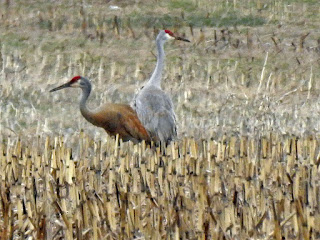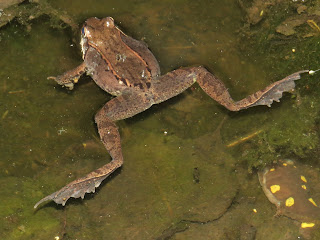NATURE MONCTON INFORMATION LINE, 20 April 2019
(Saturday)
To view the photos mentioned in this
edition go to http://nminfoline.blogspot.ca
To respond by email, please address your
message to the information line editor, nelsonpoirier435@gmail.com
Please advise the editor at nelsonpoirier435@gmail.com if any
errors are noted in wording or photo labelling. Note that corrections,
deletions, or delayed additions may not always appear on the info line and
email transcript but will always appear on the BlogSpot. For this reason, it is
recommended that those wishing to look at historical records use the BlogSpot
rather than the email transcript. The BlogSpot can always be accessed from
the website.
For more information on Nature Moncton,
check the website at www.naturemoncton.com
Edited by: Nelson Poirier nelsonpoirier435@gmail.com
Transcript by: Catherine
Clements
Info Line #: 506-384-6397 (384-NEWS)
Brian Coyle was
able to spot a pair of SANDHILL CRANES in a corn stubble field off the
Homestead Road not far from his Lower Mountain Road home on Friday. It takes
the Sandhill Crane 2 to 5 years to mature to breeding plumage but these two do
appear to have reached breeding plumage to make a breeding pair a possibility. Brian
was able to get distant photos but comments the birds appear to be quite wary
and saw them move to a nearby field making their rattling vocalization as they
did.
Brian also spotted
his FOY SAVANNAH SPARROW and FOY male AMERICAN KESTREL on Friday.
**Jim Wilson points out the photo of the
male REDHEAD DUCK [Fuligule à tête rouge] by Peter Gadd at the Newcastle water
treatment plant in the April 18th edition has a female with it that I had
labelled RING-NECKED DUCK [Fuligule à collier]. There is a male Ring-necked
Duck in the background, but the bird near the male Redhead is actually a
female. I stopped there briefly on Friday. The male Redhead was still there,
and very probably the female was as well, but weather conditions did not allow
good observations. The leucistic NORTHERN
SHOVELER [Canard souchet] was not present at the time I visited. Thank you, Jim
Wilson, for pointing out that error.
**Verica
LeBlanc paid a visit to Escuminac and
Pointe-Sapin on Wednesday. The wharf area in Escuminac was still firmly
frozen; however, she was able to enjoy watching the BLACK SCOTERS [Macreuse à
bec jaune] seemingly enjoying the very high surf that day, diving down into the
waves as the waves would approach and resurface. She caught some photographs
that show the strength and beauty of the surf. Verica then went to Pointe-Sapin, where the harbour was ice-free
and more calm, to find Black Scoters again and more cooperative for photos. She
was able to get a distant photo of a male SURF SCOTER [Macreuse à front blanc]
out in the surf away from the harbour.
**The warm wet weather is bringing out our
early amphibians. Gabriel Gallant stepped out of his Sainte-Marie-de-Kent home
at 10:00 p.m. on Friday night to hear a full chorus of WOOD FROGS [Grenouille
des bois] coming from shallow wet areas around his home. He comments that if he
listened carefully he could sometimes hear a few SPRING PEEPERS [Rainette
crucifère] calling as well. Gabriel sends a few photos of each species that he
captured five years ago as a reminder of what to see when lucky enough to spot
one of these, even as numerous as they are in the vernal
ponds.
**Jan
Tingley sends a photo of a DARK-EYED JUNCO [Junco ardoisé] Oregon
subspecies she photographed in March on Vancouver Island. The Dark-eyed Junco
has several subspecies, some of which have very different plumage from the
Dark-eyed Junco we are used to seeing in New Brunswick. The Oregon subspecies
is a bird of the West, and would create a rare bird alert if it strayed to New
Brunswick.
**When the sun was out for a short time on
Thursday, Lisa Morris was able to capture a few photos of Bees [Abeille] taking
advantage of those early-emerging and ephemeral Crocus flowers for their pollen
fix. They appeared to be Bees in the Andrena group that are all early emergers.
**Kevin Balmer shares another of his
portrait-quality photos he took of a BLACK-CAPPED CHICKADEE [Mésange à tête
noire] enjoying a sunflower seed at Mapleton Park.
**Aldo Dorio captured a photo of a male AMERICAN
KESTREL [Crécerelle d'Amérique] around the Neguac wharf on Friday. Kestrels
usually start arriving by mid-April, and the odd one earlier than that.
**Brian Stone got a photo of a Bagworm
Moth [Psyché] emerging from its pupal case as it crawled up the window of his
back door. This moth’s lifestyle is very similar to the Caddisfly [trichoptère] species that build their
similar pupal case underwater. Brian got a short video of it emerging. Take a
look at the attached link to see the real-time action.
Nelson Poirier,
Nature Moncton
AMERICAN KESTREL (MALE). APRIL 19, 2019. BRIAN COYLE
BAGWORM MOTH LARVA. APRIL 19, 2019. BRIAN STONE
BEE ON CROCUS. APRIL 18, 2019. LISA MORRIS
BEE ON CROCUS. APRIL 18, 2019. LISA MORRIS
BEE ON CROCUS. APRIL 18, 2019. LISA MORRIS
BLACK SCOTER IN SURF. APRIL 17, 2019. VERICA LeBLANC
BLACK SCOTERS (MALES AND FEMALE). APRIL 17, 2019. VERICA LeBLANC
BLACK SCOTER IN SURF. APRIL 17, 2019. VERICA LeBLANC
BLACK SCOTER IN SURF. APRIL 17, 2019. VERICA LeBLANC
BLACK-CAPPED CHICKADEE PORTRAIT. KEVIN BALMER
DARK-EYED JUNCO (OREGON SUBSPECIES). MARCH 26 , 2019. JAN TINGLEY
AMERICAN KESTREL (MALE). APRIL 19, 2019. ALDO DORIO
REDHEAD DUCK (MALE AND FEMALE) WITH RING-NECKED DUCK (MALE). APRIL 17, 2019. PETER GADD
REDHEAD DUCK (MALE AND FEMALE) WITH RING-NECKED DUCK (MALE). APRIL 17, 2019. PETER GADD
SANDHILL CRANE (ADULT PAIR). APRIL 19, 2019.. BRIAN COYLE
SANDHILL CRANE. APRIL 19, 2019.. BRIAN COYLE
SANDHILL CRANE (ADULT PAIR). APRIL 19, 2019.. BRIAN COYLE
SANDHILL CRANE. APRIL 19, 2019.. BRIAN COYLEf
SAVANNAH SPARROW. April 19, 2019. BRIAN COYLE
Spring Peeper. May 17, 2014. Gabriel Gallant
Spring Peeper. May 17, 2014. Gabriel Gallant
SURF SCOTER (ADULT MALE). APRIL 17, 2019. VERICA LeBLANC
Wood Frog. May 17, 2014. Gabriel Gallant






























































